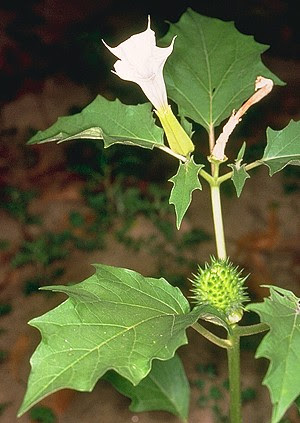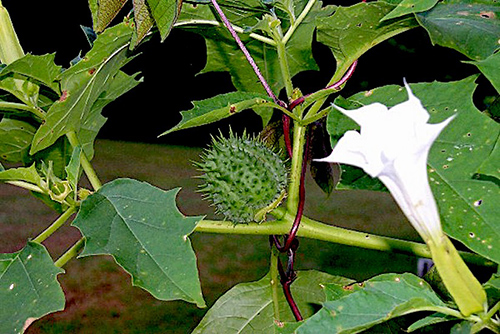Contents
The devil’s trumpet plant was unknown in Europe during ancient times and the Middle Ages until it was brought to Spain from Mexico in the late 16th century. Because of its significant effect on the nervous system, it quickly spread through Europe.

Devil’s Trumpet Plant Scientific Facts
- Other names: Devil’s apple, Jimson weed, Jamestown weed, mad-apple, nightshade, Peru-apple, stinkweed, stinkwort, stramonium, thorn-apple.
- French: Stramoine, pomme epineuse.
- Spanish: Estramonio, floripondio, chamico.
- Environment: Although originally from Central and South America, it is now found worldwide. It grows on the borders of fields and roadsides, near villages and populated areas.
- Description: This is a robust annual plant of the Solanaceae family, growing from 30 to 90 cm high. It has big, white, trumpet-shaped flowers. Its fruits are spinous, and the whole plant has an unpleasant smell.
- Parts of the plant used medicinally: Leaves.
Healing Properties and Uses

The plant contains active alkaloids that act on the autonomic nervous system (hyoscine, atropine, and scopolamine), citric and malic acids, tannins, and essential oils. Its action is similar to that of henbane and belladonna, and an inhibition of the parasympathetic nervous system characterizes it. The plant has the following properties and uses:
- Antispasmodic. It relaxes the digestive tract muscles, the bronchi, and the urinary and bile ducts.
- It has been used for all kinds of colic pain, including intestinal, digestive, and renal, and as an antiasthmatic substance.
- In external applications, it eases rheumatic pains.

WARNING! It is a stupefacient and toxic plant that produces hallucinations and mental disorders, and many of its popular Latin American names are related to this effect. Some of these names are very expressive, such as “vuelvete loco” (go mad).
How to use Devil’s Trumpet
- Being a toxic plant, it must not be used internally except under medical supervision.
- Powder made from the leaves. The maximum dose is 0.2 g three times a day.
- Poultices of mashed leaves are applied to the affected articulation.
DISCLAIMER: All content on this website is presented solely for educational and informational objectives. Do not rely on the information provided as a replacement for advice, diagnosis, or treatment from a qualified medical expert. If you are pregnant, nursing, or have any preexisting medical concerns, talk to your doctor before using any herbal or natural medicines.
REFERENCES
- George D. Pamplona-Roger, M.D. “Encyclopedia of Medicinal Plants.” George D. Pamplona-Roger, M.D. Encyclopedia of Medicinal Plants. Ed. Francesc X. Gelabert. Vols. 1 San Fernando de Henares: Editorial Safeliz, 2000. 157. Print.[devil’s trumpet plant]
- PubMed https://pubmed.ncbi.nlm.nih.gov/
- Google Scholar https://scholar.google.com/
- Botanical Safety Handbook https://abc.herbalgram.org/site/PageServer?pagename=BSH
